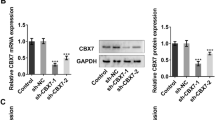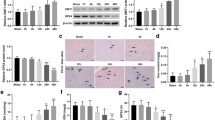Abstract
This study investigated the protective effect of the compatibility of hypaconitine (HA) and glycyrrhetinic acid (GA) on H9c2 cells under oxygen and glucose deprivation (OGD)-induced injury, and the possible mechanisms. We found that HA+GA significantly improved pathology and morphology of the nucleus and ultrastructure of H9c2 cells under OGD as determined by Hoechst 33342 staining and transmission electron microscopy (TEM) tests. It also reduced the releases of lactate dehydrogenase (LDH), creatine kinase-myocardial band isoenzyme (CK-MB), and aspartate transaminase (AST) from the cultured supernatant of H9c2 cells, which were tested by enzyme-linked immune sorbent assay (ELISA) kits. In addition, it lessened the apoptotic rate as determined by a fluorescein isothiocyanate-annexin V/propidium iodide (FITC-AV/PI) double staining assay. It was also found that HA+GA might regulate the protein expression associated with the phosphatidylinositol 3-kinase (PI3K)/Akt signaling pathway. Overall, the study demonstrated that HA+GA protected H9c2 cells against OGD-induced injury, and the signaling mechanism might be related to the PI3K/Akt signaling pathway.
中文概要
题目
次乌头碱配伍甘草次酸对缺氧缺糖损伤H9c2 心肌细胞的保护作用及其分子机制
目的
探讨次乌头碱(HA)配伍甘草次酸(GA)对缺 氧缺糖(OGD)损伤H9c2 心肌细胞的保护作用 及其作用机制。
创新点
首次在OGD 模型中证明HA+GA 对H9c2 心肌细 胞有明显的保护作用。此作用与减少细胞坏死和 凋亡有关系,且其作用机制与磷脂酰肌醇-3-激酶/ 蛋白质丝氨酸-苏氨酸激酶(PI3K/Akt)信号通路 有关。
方法
采用H9c2 心肌细胞为研究对象,将其分为七组: 正常组、OGD 模型组、OGD+HA 组、OGD+GA 组、OGD+HA+GA 组、OGD+LY294002 组、 OGD+HA+GA+LY294002 组。采用Hoechst 33342 染色荧光显微镜及透射电镜观察前五组的H9c2 心肌细胞的形态学改变;采用酶联免疫吸附测定 法(ELISA)检测前五组细胞上清液中乳酸脱氢 酶(LDH)、肌酸激酶同工酶(CK-MB)以及天 门冬氨酸氨基转移酶(AST)的释放量的改变; 采用异硫氰酸荧光素-磷脂结合蛋白V/碘化丙啶 (FITC-AV/PI)双染色法检测前五组细胞凋亡率 的情况;采用蛋白质免疫印迹法(Western blot) 检测加入抑制剂LY294002 前后丝苏氨酸蛋白激 酶(Akt)、磷酸化丝苏氨酸蛋白激酶(p-Akt)、 B 细胞淋巴瘤/白血病-2 相关x 蛋白(Bax)、B 细胞淋巴瘤/白血病-2(Bcl-2)及半胱氨酸天冬氨 酸蛋白酶-9(caspase-9)等细胞作用信号通路 PI3K/Akt 相关蛋白的情况。
结论
( 1 ) Hoechst 33342 染色荧光显微镜显示 OGD+HA+GA 组抗凋亡作用最明显;(2)透射 电镜观察OGD+HA+GA 组凋亡现象改善最多; (3)LDH、CK-MB 及AST 的含量变化显示 OGD+HA+GA 组心肌细胞损伤指标降低最多 (P<0.05);(4)Western blot 法检测结果显示 HA+GA可以减少OGD对H9c2心肌细胞的损伤, 其作用机制与PI3K/Akt 信号通路有关。
Similar content being viewed by others
References
Cai, Y., Gao, Y., Tan, G., et al., 2013. Myocardial lipidomics profiling delineate the toxicity of traditional Chinese medicine Aconiti Lateralis radix praeparata. J. Ethnopharmacol., 147(2): 349–356. http://dx.doi.org/10.1016/j.jep.2013.03.017
Chen, Z., Shen, X., Shen, F., et al., 2013. TAK1 activates AMPK-dependent cell death pathway in hydrogen peroxide-treated cardiomyocytes, inhibited by heat shock protein-70. Mol. Cell. Biochem., 377(1-2): 35–44. http://dx.doi.org/10.1007/s11010-013-1568-z
Fan, R., Li, N., Xu, H., et al., 2016. The mechanism of hydrothermal hydrolysis for glycyrrhizic acid into glycyrrhetinic acid and glycyrrhetinic acid 3-O-mono-ß-Dglucuronide in subcritical water. Food Chem., 190:912–921. http://dx.doi.org/10.1016/j.foodchem.2015.06.039
Freude, B., Masters, T.N., Robicsek, F., et al., 2000. Apoptosis is initiated by myocardial ischemia and executed during reperfusion. J. Mol. Cell. Cardiol., 32(2): 197–208. http://dx.doi.org/10.1006/jmcc.1999.1066
Gao, F., Hu, X.Y., Xie, X.J., et al., 2010. Heat shock protein 90 protects rat mesenchymal stem cells against hypoxia and serum deprivation-induced apoptosis via the PI3K/Akt and ERK1/2 pathways. J. Zhejiang Univ.-Sci. B (Biomed. & Biotechnol.), 11(8): 608–617. http://dx.doi.org/10.1631/jzus.B1001007
Gao, Q.T., Chen, X.H., Bi, K.S., 2004. Comparative pharmacokinetic behavior of glycyrrhetic acid after oral administration of glycyrrhizic acid and Gancao-Fuzi-Tang. Biol. Pharm. Bull., 27(2): 226–228. http://dx.doi.org/10.1248/bpb.27.226
He, W., Zhang, M.F., Ye, J., et al., 2010. Cordycepin induces apoptosis by enhancing JNK and p38 kinase activity and increasing the protein expression of Bcl-2 pro-apoptotic molecules. J. Zhejiang Univ.-Sci. B (Biomed. & Biotechnol.), 11(9): 654–660. http://dx.doi.org/10.1631/jzus.B1000081
Hemmings, B.A., Restuccia, D.F., 2012. PI3K-PKB/Akt pathway. Cold Spring Harb. Perspect. Biol., 4(9):a011189. http://dx.doi.org/10.1101/cshperspect.a011189
Lai, C.C., Tang, C.Y., Chiang, S.C., et al., 2015. Ischemic preconditioning activates prosurvival kinases and reduces myocardial apoptosis. J. Chin. Med. Assoc., 78(8): 460–468. http://dx.doi.org/10.1016/j.jcma.2015.04.006
Lee, Y., Gustafsson, A.B., 2009. Role of apoptosis in cardiovascular disease. Apoptosis, 14(4): 536–548. http://dx.doi.org/10.1007/s10495-008-0302-x
Liu, Q.Y., Zhang, Y.Y., Wan, H.T., et al., 2013. Detoxicated effect of compatibility of hypaconitine and liquiritin, glycyrrhetinic acid. China J. Tradit. Chin. Med. Pharm., 28(9): 2601–2604.
Liu, T., Zhu, W., Yang, X., et al., 2009. Detection of apoptosis based on the interaction between annexin V and phosphatidylserine. Anal. Chem., 81(6): 2410–2413. http://dx.doi.org/10.1021/ac801267s
Marambio, P., Toro, B., Sanhueza, C., et al., 2010. Glucose deprivation causes oxidative stress and stimulates aggresome formation and autophagy in cultured cardiac myocytes. Biochim. Biophys. Acta, 1802(6): 509–518. http://dx.doi.org/10.1016/j.bbadis.2010.02.002
Menezes, A.R., Lavie, C.J., Milani, R.V., et al., 2011. Psychological risk factors and cardiovascular disease: is it all in your head? Postgrad. Med., 123(5): 165–176. http://dx.doi.org/10.3810/pgm.2011.09.2472
Munk, P.S., Larsen, A.I., 2009. Inflammation and C-reactive protein in cardiovascular disease. Tidsskr. Nor. Laegeforen., 129(12): 1221–1224 (in Norwegian). http://dx.doi.org/10.4045/tidsskr.08.0011
Nabel, E.G., Braunwald, E., 2012. A tale of coronary artery disease and myocardial infarction. N. Engl. J. Med., 366(1): 54–63. http://dx.doi.org/10.1056/NEJMra1112570
Oudit, G.Y., Penninger, J.M., 2009. Cardiac regulation by phosphoinositide 3-kinases and PTEN. Cardiovasc. Res., 82(2): 250–260. http://dx.doi.org/10.1093/cvr/cvp014
Qiao, S., Mao, X., Wang, Y., et al., 2016. Remifentanil preconditioning reduces postischemic myocardial infarction and improves left ventricular performance via activation of the Janus activated kinase-2/signal transducers and activators of transcription-3 signal pathway and subsequent inhibition of glycogen synthase kinase-3ß in rats. Crit. Care Med., 44(3): e131–e145. http://dx.doi.org/10.1097/ccm.0000000000001350
Quan, W., Wu, B., Bai, Y., et al., 2014. Magnesium lithospermate B improves myocardial function and prevents simulated ischemia/reperfusion injury-induced H9c2 cardiomyocytes apoptosis through Akt-dependent pathway. J. Ethnopharmacol., 151(1): 714–721. http://dx.doi.org/10.1016/j.jep.2013.11.036
Rizvi, M., Jawad, N., Li, Y., et al., 2010. Effect of noble gases on oxygen and glucose deprived injury in human tubular kidney cells. Exp. Biol. Med. (Maywood), 235(7): 886–891. http://dx.doi.org/10.1258/ebm.2010.009366
Shang, M., Zhang, Q., Zhang, M.X., et al., 2013. Effects of endothelial microvesicles induced by A23187 on H9c2 cardiomyocytes. Chin. J. Appl. Physiol., 29(6): 559–564.
Shi, R., Liu, L., Huo, Y., et al., 2007. Study on protective effects of Panax notoginseng saponins on doxorubicininduced myocardial damage. China J. Chin. Mat. Med., 32(24): 2632–2635 (in Chinese).
Sun, X., Chen, R.C., Yang, Z.H., et al., 2014. Taxifolin prevents diabetic cardiomyopathy in vivo and in vitro by inhibition of oxidative stress and cell apoptosis. Food Chem. Toxicol., 63:221–232. http://dx.doi.org/10.1016/j.fct.2013.11.013
Thompson, C.B., 1995. Apoptosis in the pathogenesis and treatment of disease. Science, 267(5203): 1456–1462.
Tong, H., Chen, W., Steenbergen, C., et al., 2000. Ischemic preconditioning activates phosphatidylinositol-3-kinase upstream of protein kinase C. Circ. Res., 87(4): 309–315. http://dx.doi.org/10.1161/01.RES.87.4.309
van der Hoeven, B.L., Schalij, M.J., Delgado, V., 2012. Multimodality imaging in interventional cardiology. Nat. Rev. Cardiol., 9(6): 333–346. http://dx.doi.org/10.1038/nrcardio.2012.14
Vermes, I., Haanen, C., Steffens-Nakken, H., et al., 1995. A novel assay for apoptosis.Flow cytometric detection of phosphatidylserine expression on early apoptotic cells using fluorescein labelled Annexin V. J. Immunol. Methods, 184(1): 39–51. http://dx.doi.org/10.1016/0022-1759(95)00072-I
Wakayama, K., Fukai, M., Yamashita, K., et al., 2012. Successful transplantation of rat hearts subjected to extended cold preservation with a novel preservation solution. Transpl. Int., 25(6): 696–706. http://dx.doi.org/10.1111/j.1432-2277.2012.01469.x
Wang, J., Ji, S.Y., Liu, S.Z., et al., 2015. Cardioprotective effect of breviscapine: inhibition of apoptosis in H9c2 cardiomyocytes via the PI3K/Akt/eNOS pathway following simulated ischemia/reperfusion injury. Pharmazie, 70(9): 593–597.
Wang, J.X., Zhang, X.J., Li, Q., et al., 2015. MicroRNA-103/107 regulate programmed necrosis and myocardial ischemia/reperfusion injury through targeting FADD. Circ. Res., 117(4): 352–363. http://dx.doi.org/10.1161/circresaha.117.305781
Wu, H.J., Yang, J.Y., Jin, M., et al., 2015. Glycyrrhetinic acid protects the heart from ischemia/reperfusion injury by attenuating the susceptibility and incidence of fatal ventricular arrhythmia during the reperfusion period in the rat hearts. Cell. Physiol. Biochem., 36(2): 741–752. http://dx.doi.org/10.1159/000430134
Xie, S., Jia, Y., Liu, A., et al., 2015. Hypaconitine-induced QTprolongation mediated through inhibition of KCNH2 (hERG) potassium channels in conscious dogs. J. Ethnopharmacol., 166:375–379. http://dx.doi.org/10.1016/j.jep.2015.03.023
Yang, Y., Yin, X.J., Guo, H.M., et al., 2014. Identification and comparative analysis of the major chemical constituents in the extracts of single Fuzi herb and Fuzi-Gancao herb-pair by UFLC-IT-TOF/MS. Chin. J. Nat. Med., 12(7): 542–553. http://dx.doi.org/10.1016/s1875-5364(14)60084-4
Yu, B., Cao, Y., Xiong, Y.K., 2015. Pharmacokinetics of aconitine-type alkaloids after oral administration of Fuzi (Aconiti Lateralis Radix Praeparata) in rats with chronic heart failure by microdialysis and ultra-high performance liquid chromatography-tandem mass spectrometry. J. Ethnopharmacol., 165:173–179. http://dx.doi.org/10.1016/j.jep.2015.01.057
Yu, H.T., Zhen, J., Pang, B., et al., 2015. Ginsenoside Rg1 ameliorates oxidative stress and myocardial apoptosis in streptozotocin-induced diabetic rats. J. Zhejiang Univ.-Sci. B (Biomed. & Biotechnol.), 16(5): 344–354. http://dx.doi.org/10.1631/jzus.B1400204
Yu, L.N., Yu, J., Zhang, F.J., et al., 2010. Sevoflurane postconditioning reduces myocardial reperfusion injury in rat isolated hearts via activation of PI3K/Akt signaling and modulation of Bcl-2 family proteins. J. Zhejiang Univ.-Sci. B (Biomed. & Biotechnol.), 11(9): 661–672. http://dx.doi.org/10.1631/jzus.B1000155
Yucel, A.F., Kanter, M., Pergel, A., et al., 2011. The role of curcumin on intestinal oxidative stress, cell proliferation and apoptosis after ischemia/reperfusion injury in rats. J. Mol. Histol., 42(6): 579–587. http://dx.doi.org/10.1007/s10735-011-9364-0
Yue, H., Pi, Z.F., Li, H.L., et al., 2008. Studies on the stability of diester-diterpenoid alkaloids from the genus Aconitum L.by high performance liquid chromatography combined with electrospray ionisation tandem mass spectrometry (HPLC/ESI/MSn). Phytochem. Anal., 19(2): 141–147. http://dx.doi.org/10.1002/pca.1027
Zhang, J.M., Liao, W., He, Y.X., et al., 2013. Study on intestinal absorption and pharmacokinetic characterization of diester diterpenoid alkaloids in precipitation derived from Fuzi-Gancao herb-pair decoction for its potential interaction mechanism investigation. J. Ethnopharmacol., 147(1): 128–135. http://dx.doi.org/10.1016/j.jep.2013.02.019
Zhang, W., Zhang, H., Sun, S., et al., 2015. Comparative pharmacokinetics of hypaconitine after oral administration of pure hypaconitine, Aconitum carmichaelii extract and Sini Decoction to rats. Molecules, 20(1): 1560–1570. http://dx.doi.org/10.3390/molecules20011560
Zhao, D., Wang, J., Cui, Y., et al., 2012. Pharmacological effects of Chinese herb aconite (Fuzi) on cardiovascular system. J. Tradit. Chin. Med., 32(3): 308–313. http://dx.doi.org/10.1016/S0254-6272(13)60030-8
Zheng, K., Sheng, Z., Li, Y., et al., 2014. Salidroside inhibits oxygen glucose deprivation (OGD)/re-oxygenation-induced H9c2 cell necrosis through activating of Akt-Nrf2 signaling. Biochem. Biophys. Res. Commun., 451(1): 79–85. http://dx.doi.org/10.1016/j.bbrc.2014.07.072
Zhou, G., Tang, L., Zhou, X., et al., 2015. A review on phytochemistry and pharmacological activities of the processed lateral root of Aconitum carmichaelii Debeaux. J. Ethnopharmacol., 160:173–193. http://dx.doi.org/10.1016/j.jep.2014.11.043
Author information
Authors and Affiliations
Corresponding author
Additional information
Project supported by the National Natural Science Foundation of China (Nos. 81473412, 81573868, and 81630105), the Zhejiang Provincial Natural Science Foundation of China (No. LZ17H270001), and the Zhejiang Provincial Program for the Cultivation of High-Level Innovative Health Talents, China
ORCID: Li-qin WANG, http://orcid.org/0000-0003-1181-116X
Rights and permissions
About this article
Cite this article
Wang, Lq., He, Y., Wan, Hf. et al. Protective mechanisms of hypaconitine and glycyrrhetinic acid compatibility in oxygen and glucose deprivation injury. J. Zhejiang Univ. Sci. B 18, 586–596 (2017). https://doi.org/10.1631/jzus.B1600270
Received:
Accepted:
Published:
Issue Date:
DOI: https://doi.org/10.1631/jzus.B1600270




